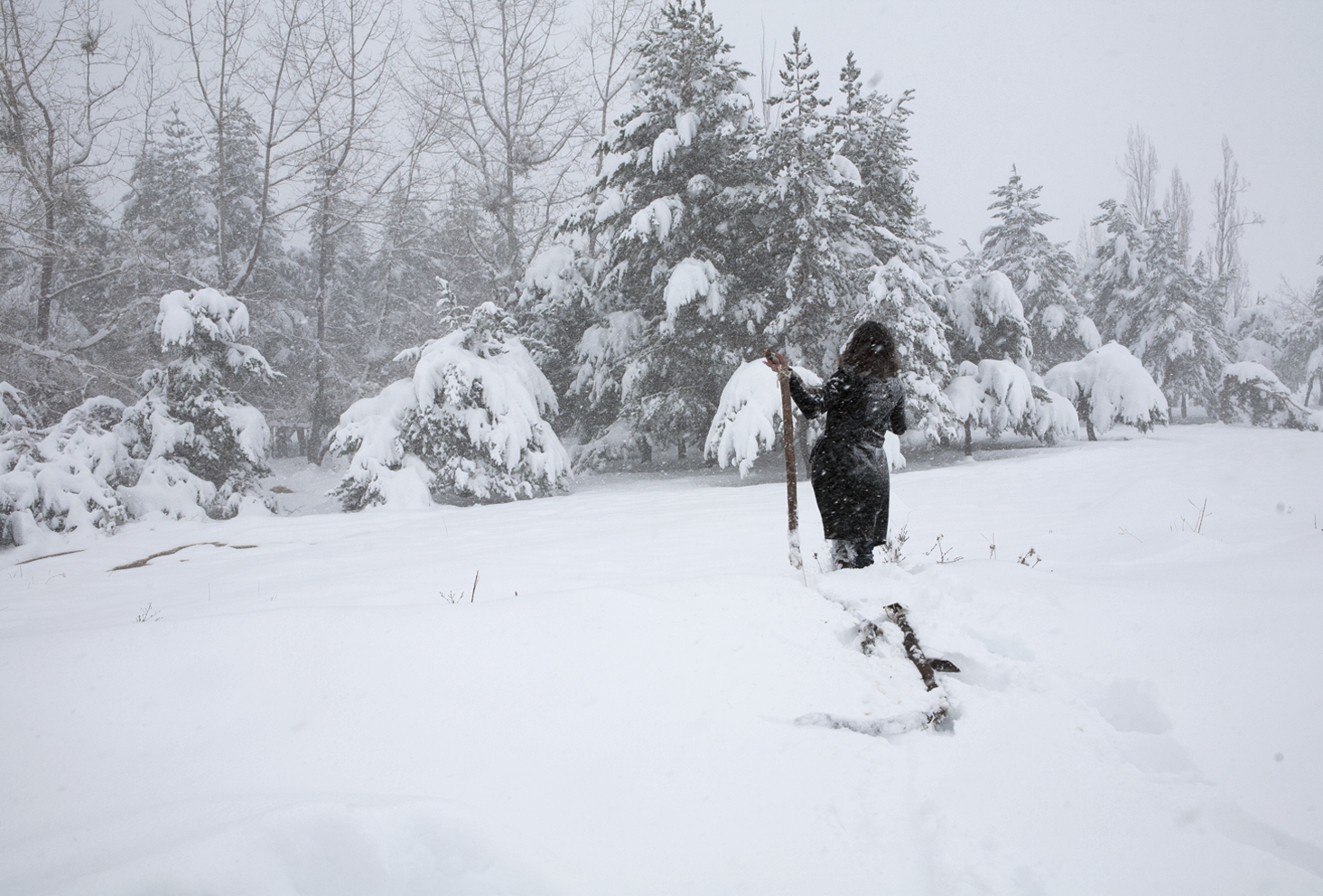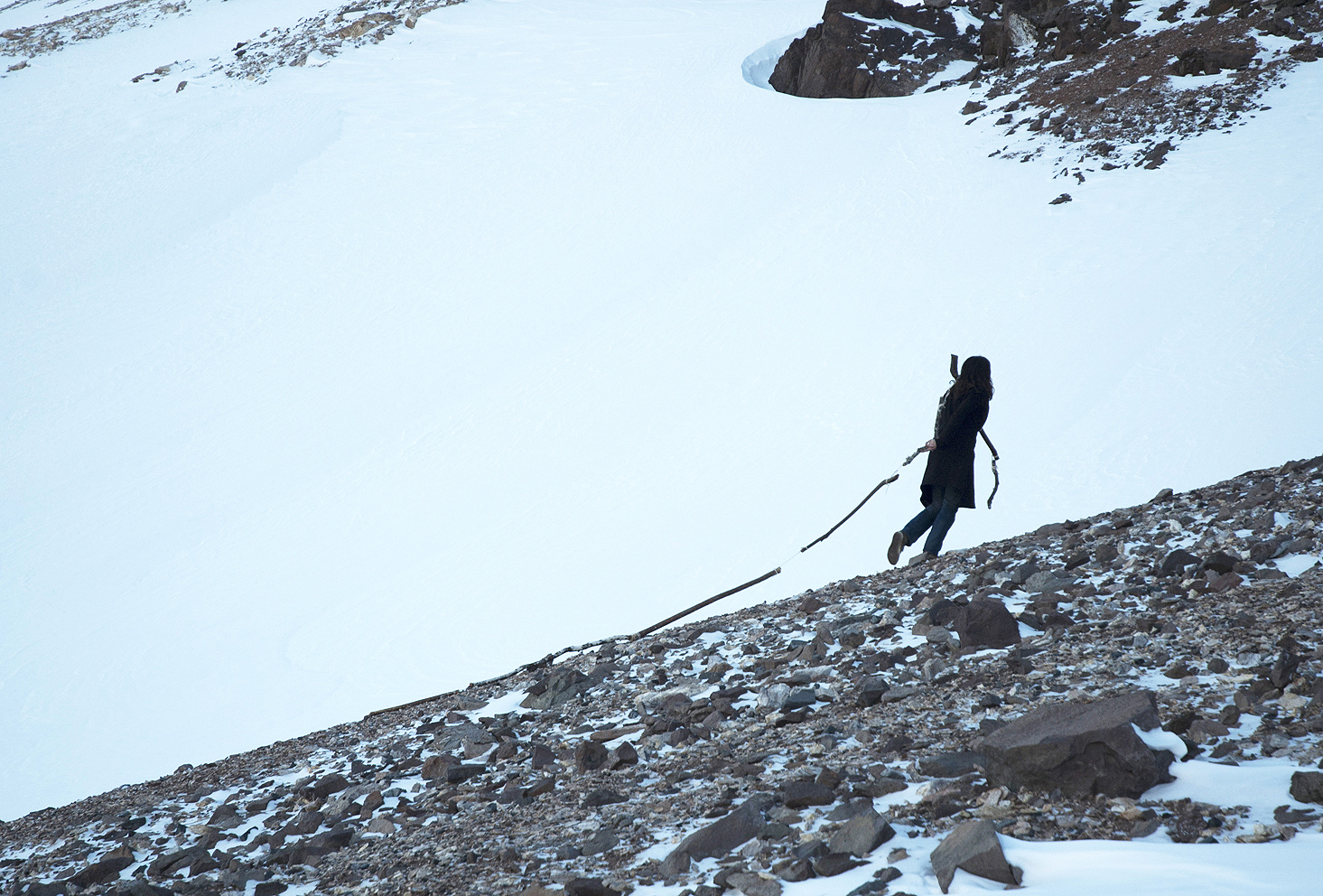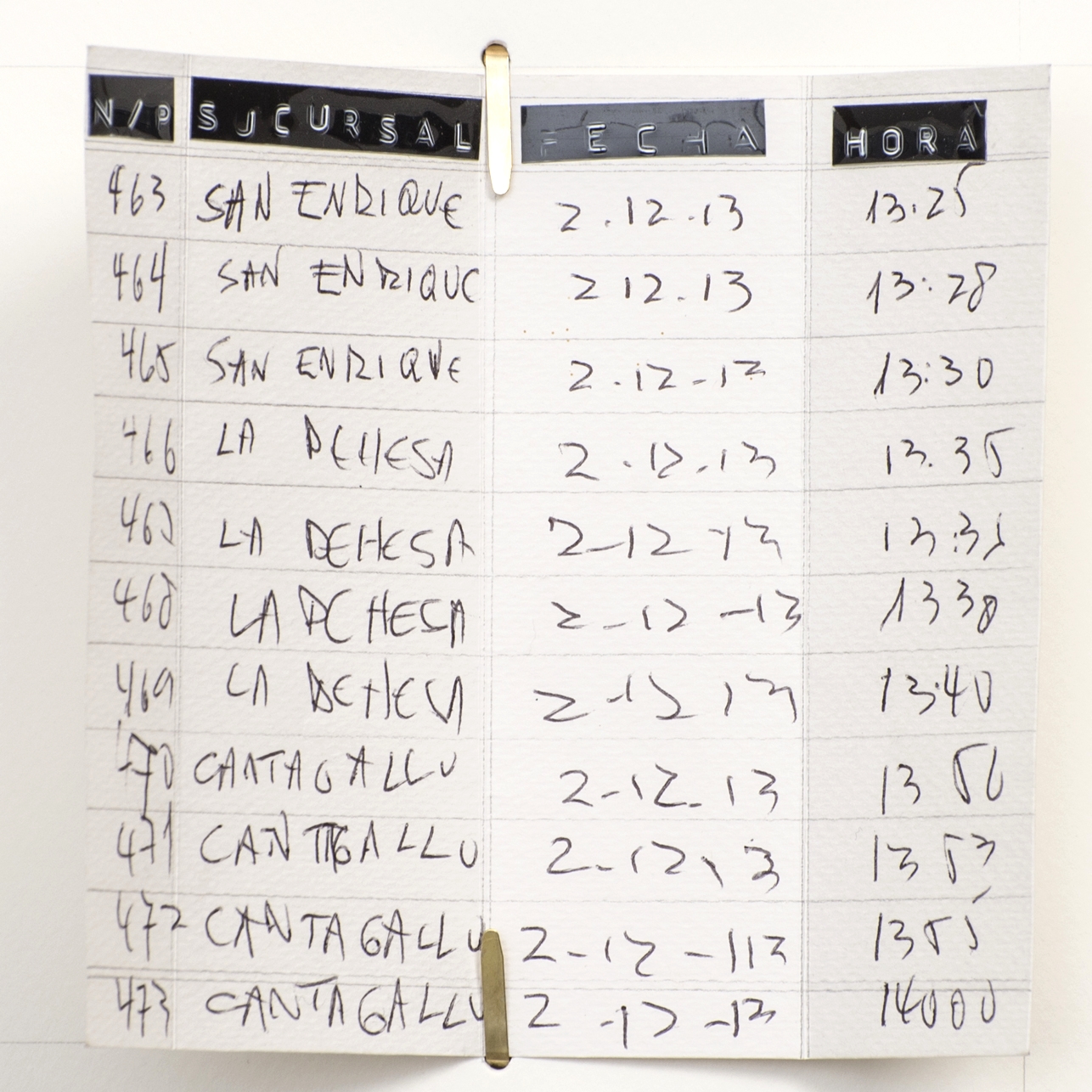Transcripción de una nota de voz de veintiocho minutos y treinta y nueve segundos realizada el día 23 de septiembre del año 2014.
THIS IS NOT MY LAND
Comencé a trabajar en el proyecto Otros Viajes hace más de tres años. El punto de partida fue un dato biográfico: nací en Estados Unidos y vivo en Santiago de Chile, tengo dos nacionalidades la chilena y la norteamericana. Me repetía constantemente la frase “esta no es mi tierra / this is not my land”, y llegué a pensar en cómo podía interpretarla sobre el territorio, como tierra y paisaje más que país. A partir de esa reflexión empecé a recorrer Chile, haciendo acciones efímeras en el paisaje, escribía en torno a mi cuerpo, en cuclillas, con cualquier elemento que recogía, una piedra, un palo, una moneda del bolsillo, el texto “esta no es mi tierra / this is not my land”, dejaba luego estos dos textos como marcas en el territorio como una huella efímera del paso del cuerpo.
During 2009 and 2010, I performed "Esta no es mi Tierra /This is not my Land" on various Chilean landscapes as a reflection upon my origins and my territory: I was born in the USA but I live in Santiago, Chile, which means that I have two nationalities.
The phrase "Esta no es mi Tierra / This is not my Land" constantly repeated itself, and left me thinking how I could interpret my territory, as land and landscape more than a country. Starting from this reflection, I toured Chile performing fleeting actions on the landscape: writing around my body whilst squatted— with whichever implement I could find: a stone, a stick, a coin — the text "Esta no es mi Tierra /This is not my Land”, immediately leaving these two texts as a mark on the territory and as a fleeting footprint of the body's passage through it.
These tours and exercises, which I named "small equivocations without consequence" (taken from the text of writer, Antonio Tabucchi), were my first approximations to the landscape as a place of artistic exploration and as a biographical inscription.
LOS PALOS
A partir de estos recorridos y ejercicios, que llamé “pequeños equívocos sin importancia” (extraído del texto del escritor Antonio Tabucchi) empecé a recorrer Chile y dentro de esos viajes, a recolectar ramas recogidas de distintos lugares.
La rama cumplía la función en un primer momento de un bastón, una prolongación del cuerpo sobre el lugar, era un elemento que me servía de apoyo para explorar y atravesar un lugar y conocerlo, y luego estos palos recogidos los llevaba a mi taller armando una colección de ramas. Cada uno de ellos los tallé con palabras que elegí del inglés: here, somewhere, anywhere, elsewhere, nowhere … que no tienen una traducción literal al español, y hacen referencia al cuerpo en relación a un lugar, a su ubicación. Here lo podríamos traducir como “acá”, anywhere como “en cualquier parte”, hay una referencia a nuestra ubicación con otra parte, con el doquier, y el doquier no es un lugar. Entonces -estas ramas recogidas y talladas con estas palabras- fueron las que armaron un cuerpo de colección la cual di por terminada cuando encontré un palo para cada palabra elegida.
The body in movement allowed me to think while walking. As a substitute for the sculptural object, I collected some sticks and branches that had fallen from the landscape. In the walk, body and sticks became equal.
The body fulfilled, in the first place, the function of a cane as an extension over the place; it was an element that served me as a support to explore and cross a place and to know it. Immediately, these collected sticks would be taken to my studio where I began to build a collection of branches. I carved each one of them with words chosen from the English language: here, somewhere, anywhere…, words that did not have a literal translation to Spanish and made reference to the body in relation to a place, its location. "Here" could be translated as "acá", "anywhere" as "en cualquier parte"… there is a reference to our location with another place, with everywhere and everywhere is not a place. Thus, these— the collected branches carved with these words— made up a collected body, that I only considered complete when I had found a stick for each chosen word.











LAS POSTALES
Me propuse hacer circular mi colección de 953 fotografías de los viajes en un soporte postal como pieza única. En el reverso de cada postal con timbres y tinta estampé las coordenadas geográficas del lugar donde había sucedido la acción que aparecía en cada fotografía en horas y minutos señalando una zona y no un punto especifico, lo que según el funcionario del Instituto geográfico militar (IGM) a quien consulté era correcto por el sentido de recorrido que tenía mi trabajo.
Arrendé una casilla en Correos de Chile de la Plaza de Armas. La casilla me permitió ser un número descorporizado, el número 1081, haciendo del cuerpo un habitáculo de aproximadamente 30 x 15 x 12 centímetros, de bronce sobre una pared del hall del edificio de correos junto a cientos de casillas. En este contenedor las postales empezaron a llegar después de su circulación por distintos lugares de la ciudad hacia un destinatario anónimo y sin cuerpo.
I assembled a collection of 953 photographs from my travels in different locations, with diverse reliefs and landscape conditions, displaying the actions performed with the sticks. I decided to distribute the collection of photographs from the trips as postcards. On the back of each postcard, with stamps and ink, I stamped the geographical coordinates of the place where I carried out the action shown on each photograph. Registered with hours and minutes, they pointed to an area and not a specific point, that which according to a staff member I consulted at the Instituto Geográfico Militar (IGM - Military Geographic Institute) was the correct approach given the direction of travel of my work.
I rented a mailbox in the Plaza de Armas, which in Santiago is kilometre 0, the place from which all distances are measured. The mailbox allowed me to be a disembodied number, the number 1081, in a cabin of approximately 30x15x12 centimeters made out of bronze and placed on a wall at the post office lobby, alongside hundreds of identical boxes. In this container, the postcards began arriving, after their circulation through different parts of the city, to an anonymous and bodiless recipient.
Edificio de Correos de Chile, Plaza de Armas, Santiago
Anverso Postal, timbres con coordenadas geográficas, matasellos de correos, caligrafía y estampilla.
LOS COLABORADORES
Solicité ayuda a un número de colaboradores para los envíos de las postales, que circulasen por distintas zonas de Santiago de acuerdo a su rutina y recorridos cotidianos esto me permitiría que parte de mi planificación y de mi riguroso método estuviera sujeto al azar y la deriva. A cada uno de ellos les entregaba un paquete de once postales ya preparadas con la dirección y la estampilla, la tarea era acercarse al correo, introducir la postal en el buzón y anotar en la bitácora de viaje los datos solicitados. Para esto diseñé una bitácora del viaje postal, un papel plegado con una simbología: NP, número de folio de la postal, la fecha y la hora de envío y la sucursal de correos en la cual depositaban la postal en el buzón. Sobretodo debían cuidar este papel ya que después lo recuperaría para ser parte del proyecto. Al mismo tiempo algunos de mis colaboradores solicitaron ayuda a otras personas ampliando la red a treinta ciudadanos entusiastas esto quedó reflejado en la escritura de los datos de envío de la bitácora que les entregué.
I sought the assistance of a number of collaborators in order to send the postcards. The idea was that they would circulate through different places in Santiago, in accordance with their routine and daily rounds, which would allow that part of my planning and rigorous method would be subject to chance and loss. To each, I handed a package of eleven postcards already addressed and stamped. The task was to go to the post box, insert the postcard and note the requested information in the travel logbook. For this, I designed a postal trip logbook: a folded piece of paper with a set of symbols: postal code (ZIP no.), folio number of postcard, date and time of posting and the post office branch from which the postcard was mailed.
Most importantly, they had to keep this piece of paper so that afterwards I could recover it as part of the project. At the same time, some of my collaborators asked for the help of others, increasing the network to thirty enthusiastic citizens, which was reflected in the logbook I handed them.
Paquete de 11 postales entregado a los colaboradores con papel de bitácora del viaje postal
EL ARCHIVO
Viajar de manera sistemática y con un propósito hacia la casilla de correos, era un rito organizado y autoimpuesto: entrar al correo, acercarme a la maquina y presionar la pantalla de número atención al cliente, sacar el papelito tipo fax y guardarlo evidenciaba mi paso por el lugar con un número de espera en una fecha y a una hora exacta en horas y minutos. Entonces con mi llave abría la casilla y retiraba las postales, a veces encontraba una buena cantidad y muchas otras regresaba desilusionada y con “las manos vacías” . Las postales fueron enviadas en distintos momentos, lugares y por diferentes colaboradores, al recolectarlas en un solo instante, se sumaban, intercalaban y superponían los viajes de cada una de estas personas, al salir del edifico de correos pensaba que bajo mi brazo llevaba y contenía los momentos y viajes de los otros.
Travelling to the mailbox, in a systematic and purposeful manner was an organised and self-imposed ritual: entering the post office, approaching the ticketing machine to select the customer service option on the screen, retrieving the service ticket, printed on fax paper, and keeping it would show my passing through the place, with the queue waiting number marked with the exact time: hours and minutes.
Then, with my key, I would open the mailbox and retrieve the postcards, sometimes I would find a good number, other times I would return disillusioned and empty-handed. The postcards were sent at different times, from various places and by different people. Recollecting them in a single moment, they would add up, superimposing the journey of each of these persons. Leaving the post office, I would think that under my arms I carried the moments and journeys of others.
Colección de números de atención de Correos de Chile de la Plaza de Armas
TRANSCRIPCIONES
Una vez que regresaba en mi casa-taller en una máquina de escribir antigua, cuya cinta no corría, transcribía el relato del viaje, Viaje 37: “salida de casa a las 10:45, camino hacia el norte, bajo a la estación M, espero en el andén, avanzo hacia la estación B, subo las escaleras, camino hacia el noreste…”. Estos papeles mecanografiados van desde el negro al blanco, haciendo visible el golpe de cada letra de la máquina de escribir sobre el papel dejando una huella y un relieve, lo que me interesaba era el golpe más que la escritura. Este era el rito final del viaje, finalmente quedaba todo contenido y transcrito en un papelito de manera precaria.
Once I returned to my home-studio, on an antique typewriter without a running tape, I would transcribe the story of the journey. Journey 37: "left home at 10:45, walked to the North, exited at station M, waited on the platform, continued to station B, climbed the stairs towards the Northeast…". These typewritten notes range from black to white, making visible the stroke of each typewritten letter on the paper, leaving a footprint and a relief: what interested me was the stroke more than the type. This was the final ritual of the journey, resulting in all the content being transcribed on a little piece of paper in a precarious manner.
Colección de Mecanografías de los relatos de los viajes hacia la casilla.
la instalación
museo de arte contemporáneo
La instalación Otros Viajes en el Museo de Arte Contemporáneo de Santiago de Chile me permitió dar cuerpo y visibilidad a experiencias acumuladas en el tiempo. Construí una serie de objetos de archivo de estas experiencias: papeles precarios contenidos en cajones y sobres. Este archivo desplegado lo instalé sobre un mesón de 18 metros de largo mostrando el anverso y el reverso de cada postal, para generar un recorrido, un paseo del espectador en torno al viaje. La disposición de los otros documentos expuestos en la sala (tarjetones de envío, recibos de correos, relatos de los viajes) daba ciertas luces y pistas para que fuera el propio espectador quien descubriese -con mirada atenta y, como un investigador en la escena del crimen, la intriga de Otros Viajes.
This file, as it is sorted through, gave body to the work "Other Journeys" exhibited in March 2014 at the Museo de Arte Contemporáneo de Santiago de Chile (Museum of Contemporary Art, Santiago, Chile).
The exhibition was made up of hundreds of postcards of my exploratory journeys, the sticks and a document file that registered the postal circulation. The postcards were presented on an 18-meter long table showing the front and back of each; thereby generating another trip, that of the exhibition visitor around the journey. The layout of the file made up of the various documents exposed in the room (the receipts proving dispatch of the postcards by the collaborators, postal receipts, accounts of travel to the post box) gave certain insights and hints to the spectator so that, from the outside, the very spectator would be the one to discover, with watchful eye and, like an investigator at the scene of a crime — the intrigue of Others' Journeys.
CORREOS DE CHILE
Después de un tiempo instalé mi colección de postales en el edificio principal de Correos de Chile de la Plaza de Armas de Santiago. Así las postales regresaban al lugar donde anteriormente habían finalizado sus viajes. En sus reversos revelaban las intervenciones realizadas por los mismos funcionarios del lugar quienes tiempo atrás estamparon, en una acción mecanizada y sistemática, los matasellos afectando, sin saber, su visualidad y, al mismo tiempo, legitimando el propio viaje de cada postal.
After some time, I exhibited my collection at the headquarters of the Correos de Chile (Chilean Postal Service) at the Plaza de Armas in Santiago. Thus, the postcards returned to where they had arrived, completing their journey. The reverse side of each one revealed the interventions carried out by the same officials who had stamped them some time ago, in a mechanical and systematic action. The postmarks affecting, without knowing, the appearance and, at the same time, legitimising the journey of each postcard.





























